West Bengal Institute of Technology (WBIT) 2009-2nd Sem B.Tech Electronics and Communications Engineering Electronics
254 WBUT SOLVED BOOK
where Q, is the heat transferred to the heat engine from a high temperature reservoir at Tt and Q, is the heat rejected to a low temperature reservoir at Tt
From the thermodynamic temperature scale '
Then the efficiency of a Carnot heat engine becomes
- Ither, Carnot = 1 ~ZT
Let T, be increased by AT, keeping T2 constant,
T2-at
12 = !-
*1 .
T-.-AT
n2-m = i-
--]+
_2_ _,T1T2-(T|+AT)(T2-AT) _ (T[ +T2)AT(AT}2
Ti + AT T,(T, + AT) T,(T1 + AT)
Since TT >12-11, > 0
The more effective way to increase the efficiency engine is to decrease the lower temperature T2.
12. (a) Derive an expression of actual discharge through a ventunmeter tube, 5
(b) Write Bernoullis equation and describe the various terms in it.
What are the assumptions involved in derivation of Bernoullis equations? 3+2
(c) In the figure, the fluid flowing in (W#ir= I2N/m3) and the manometric fluid is merian red oil (specific gravity = 0.827). Assuming no loss, compute the flow rate. 5
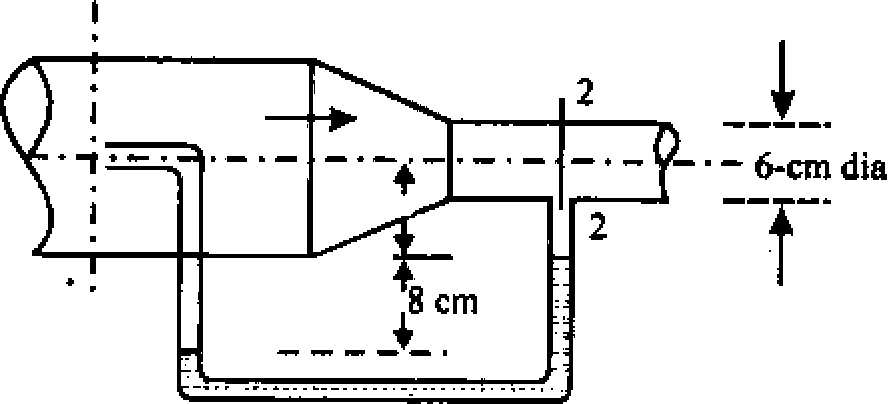 |
|
Ans. (a) There is no loss of energy and applying Bernoullis equation. r, w2 1 >2 |
10-cm dia
pg
From the continuity equation. AjVj - A2V2
V? = Vj
2 A2 1
Substituting in the equation (1), we have
A '2
(Pl-P2)
{Z[-Z2)
-1
= 2g
Pg
(P1-P2)
(z\ _z2)
2g
V,=
.ff-Volume flow rate,
a22
Pg
(P1-P2)
A|A2
+ (zi -z2)
Ps
Q = A,V,=
Pg
A2 AjA2
V2gH
Q =
/a,2-a2
(P1-P2)
+ (zl ~z2)
where H =
Pg
The value of H in the equation (4) can be found from the reading of the U-tube differential manometer. Assuming that the connections to the gauge are filled with the fluid flowing in the pipeline, which has a density pw and that the density of manometric fluid is pm. Then, since pressures at level XX must be same in both limbs,
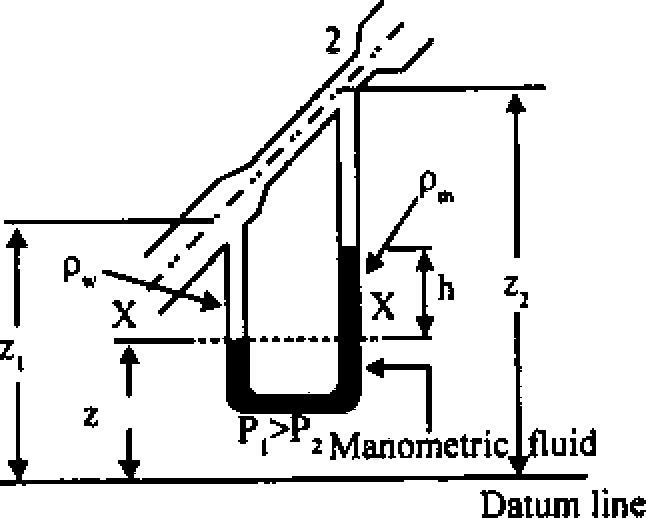 |
|
Venturimeter |
256 WBUT SOLVED BOOK
PX = Pl+ PwS (zi z) ~ P2+ Pw8 (z2 * ~ h> + PmAhg
H =
= h
Pg
AAt (
Pm. j Pw
Equation (5) can be written as, Q = , - - J2gh
Va?-.a?
2 .. .
A coefficient of discharge Cd is, therefore* introduced, which is defined as the ratio of actual dischange to that of theoretical discharge. .
cd=.5sa. .
0th , . The usual value of Cd varies from 0.95 to 0.99.
Actual discharge, = Cd x
Pm _j'
Pw j
. . P V2
Ans. (b) Bernoullis equation can be written as +--+z = C
Pg 2g
The constant C is known as Bernoullis constant which is constant for a streamline and varies from one streamline to another.
' . ' . . : " ' . .
is the pressure head (pressure energy per unit weight). It represents the height of a
Pg
V2
fluid columnthat produces that produces the static pressure P. is the velocity head (kinetic energy per unit weight). It represents the elevation needed for afluid to reach the velocity V during frictionless free fall, z is the potential head (potential energy per unit weight). It represents the potential energy of the fluid. . .
The assumptions made in the derivation of Bernoullis equations are as follows :
(i) the flow is'along a streamline,
(ii) the flow is frictionless i.e., non-viscous.
(iii) the flow is steady. '
(iv) the fluid is incompressible.
Ans. (c) p, = 12 N/m2
Density of air, pait = 1.2 kg/m2 , ? .....
Density of manometric fluid, pm =%(0.827)(1000) = 827 kg/m?
From the manometer reading, we get the downstream pressure.
Pi - P2 = (Pm- Pair)gh = <827 " L2> (9.81)(0.08) = 648.09 Pa Applying the Bernoulli equation between section 1-1 and 2-2, we have
1 1 w2
P|VpairVl =P2+7PairV2 _ _
V Pair V 1/2 .
Flow rate, Q = A,V., = "(0 06)2 (32-87) - 0 0929 m3/s.
- - 4
13. (a) Draw the rheological curve for a class of Newtonian and non-Newtonian fluid.
3
(b) State and prove hydrostatic law of a fluid, what is the stagnation pressure at a point in a fluid flow? 3+2
(c) Determine the pressure difference between points A and B. Specific gravities of benzene, kerosene and air are 0.88, 0.82 and 1.2 * 10-3 respectively.
Ans. (a) The Newtonian fluids behave according to Newton's law of viscosity that shear stress is linearly proportional to the velocity gradient for-parallel flow. Thus for Newtonian fluids, the plot of shear stress against velocity gcadient is a straight line passing through the origin. Common fluids, such as water and air are Newtonian fluids.
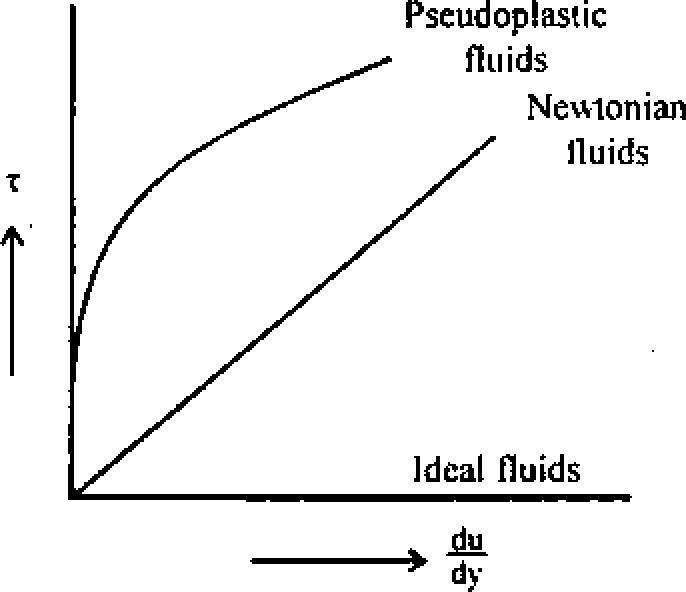 |
|
Rheological diagram |
There are certain fluids where the linear relationship between the shear stress and the deformation rate (velocity gradient in parallel flow) is not valid. Because of the deviation from Newtons law of viscosity they are commonly termed as non-Newonian fluids. Examples of pseudopla5tic fluids are blood, milk, gelatine, etc.
Ans. (b) The hydrostatic law states that the rate of decrease of pressure in the vertically upward direction is equal to the specific weight of the fluid. Mathematically.
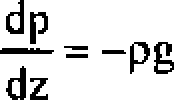
Consider a differential fluid-element at rest in rectangular Cartesian coordinates with the z-axis vertically upwards. .
The forces acting on the fluid element at rest, are of surface forces and body forces. The only body force in thermodynamics is the gravity force. .
The body force acting on the fluid element = pg Ax Ay Az and is acting vertically downward. The body force along the z direction is ,
-pg Ax Ay Az
Since the fluid element is at rest, the shear stress acting On the element will be zero. The only surface force is the pressure force.
Let the pressure at the centre of the element be P.
' - - - - : - - 9P Az The pressure at the bottom face (normal to the z axis) of the element is P----:
. . az 2
* , . A 7.
The pressure at the top face (normal to the z-axis) of the element is P +
. - ;. j dz 2
( -BP Az\ .
The force exerted on the bottom face is
y OX 2 J
3P AzV ---[Ax-,
The force exerted on the top face is P + ~ Jx
Similarly the forces acting on the left and right faces (normal to the x direction) are
5P AxV .fp,5P
- Ay Az and P + ~ Ay i
P - jAy Az and P + ~ Az respectively.
Ax-Az and
dy 2
v
'P.+.s
dy 2
The forces acting on faces normal to the y direction are Ax-Az respectively.
' , " dp -
Net forces acting on the element in the z direction, 5F =---AxAyAz - pgAxAyAz
' z dz
Similarly, net forces acting on the element in the x direction,
8F = - AxAyAz
- dx : '
Net forces acting on the element in the y direction, SFy AxAyAz
From Newtons second law, a force balance in the x, y and z direction gives :

 |
|
P |
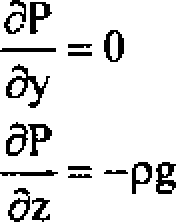
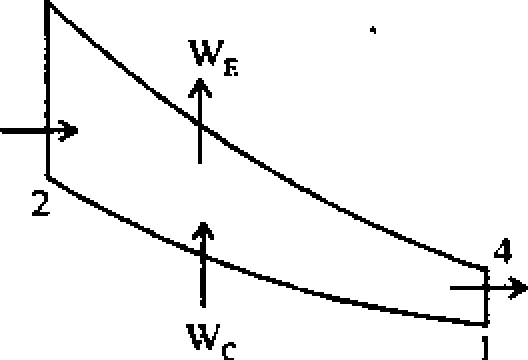
|
-> v Variation of fluid pressure 5P |
 |
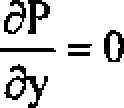
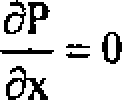
Two points at the same elevation in the same continuous mass of fluid at rest have the same pressure. .
P is a function of z only = -pg
dz
The sum of the static pressure and dynamic pressure is called the stagnation pressure. The pressure at a point in a frictionless flow where the fluid velocity is zero is known as the stagnation pressure.
Ans. (c) We know that pressure variation in any static fluid is described by the relation dp _ dp _ '
= -pg
dz dh
|
or, dp = pgdh | 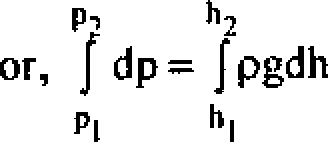 |
Assuming constant density fluid, we get P2 - Pj - Pg(h2 - h])
Beginning at point A and applying the equation between successive points along the manometer gives
PC " Pa = P Benzene S*11
Pd PC = PMercury 82 PE - PD = PKerosene 8h3 PF - PE = PWater 4 PB ~ PF = Pair
|
Kerosene |
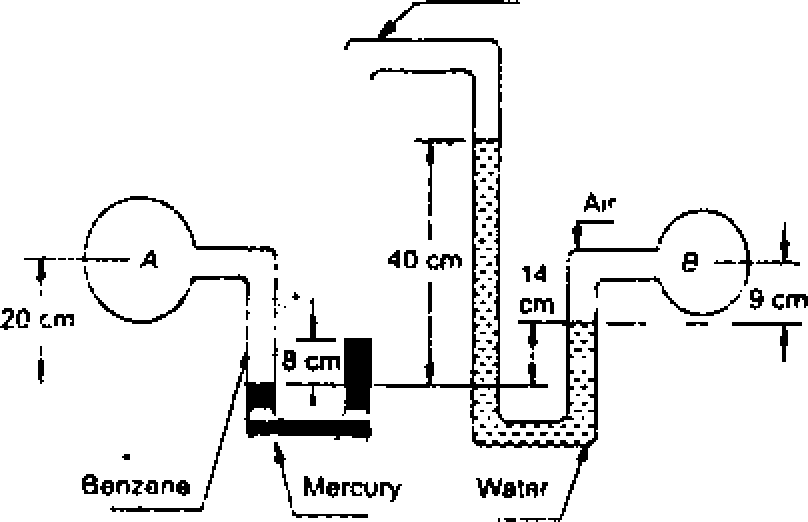 |
Multiplying each equation by minits one and then adding, we get
Pb PBenzene *1 r PMercury PRerosene ? * Pwater 84 Pair 55
= - 0.8811000)(9.81 >(0.2) + 13.6( 1000)(9.81 )(0.08) '
* 0.8 2|1 IIOil]|9.81 |(0.3Z| I 1 1 0 0 0|19.811(06j + 1.1 * 10O 000)(9.81 )(0.09) = 8971.32 Pa =* 8.97 kPa.
|
Attachment: |
| Earning: Approval pending. |
